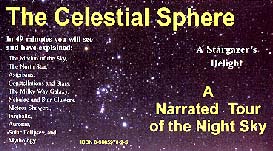| ________________CM
. . . . Volume VIII Number 2 . . . . September 21, 2001
excerpt: "The appearance of the sky in The Celestial Sphere is similar to what an observer will see from a reasonably dark observing site. So until you are able to travel out into the country, this film may be your best view of the night sky. From the city we can see only a few of the brightest stars. Many more can be seen from a dark site. So many in fact that recognizing some of the constellations can be difficult, as the brightest stars are nearly overwhelmed by the swarms of fainter ones that become visible. Therefore, the videotape is a good introduction to a dark rural sky." ( The Celestial Sphere: Educator's Supplement., p. 3.) As noted above, the budding stargazer may find him/herself in a Goldilocks-type situation. Instead of porridge that is too hot or too cold, the novice astronomer may move from a situation of too few stars being visible in a light polluted urban area to being overwhelmed by too many stars in a pristine rural sky. In the videotape, The Celestial Sphere, Dick controls the stimuli by reproducing the movement of the night sky via animated photographic stills that were taken month after month over several years. Most of the tape is given over to identifying some of the major constellations and asterisms (the Big and Little Dipper, for example, which are given names because of their shapes but which are actually parts of the constellations Ursa Major and Minor, respectively), plus their principal stars. To help the viewer "see" the constellation or asterism, the various stars are linked by lines and the appropriate stars are named. The remainder of the video is given over to other celestial objects, such as nebulas, star clusters, comets, meteors, the Aurora Borealis and a solar eclipse. As the camera reproduces what is seen by the naked eye, Dick utilizes special inserts to show how various deep sky objects would appear if viewed through binoculars. The videotape's big advantage is that viewers can see the night sky at any time, without having to take into account such factors as weather, insects, or time of day/night. The downside is that the photographic lens can never truly capture what the eye sees, and so the video's stars do not look like real stars. As well, even a wide angle lens ultimately has limits, and the viewer cannot see more than the television monitor will allow. Consequently, unlike the real night sky, where I can get my bearings by locating an already familiar constellation or asterism in order to find a relatively nearby unknown one, my "video range of vision" is constrained by the TV screen. The narrator's voice is quite clear and pleasant, but, at times, the background music annoyingly overwhelms the narration. Given that supporting materials claimed that the videotape was "developed for 10 year old children up to senior citizens," greater care could have been taken in the choice of vocabulary for younger viewers. As well, the inclusion of poetry will also be lost on most junior listeners. Unfortunately, lunar eclipses, which are more frequently seen by sky observers than solar eclipses, are left to another future video as are the planets. Though the video's running time is shown as 49 minutes, the final seven minutes, which follow the closing credits, are just various animated views of the night sky accompanied by music. To use The Celestial Sphere effectively, one should also purchase the Educator's Supplement which is made up of three major sections. The first part is a brief "Introduction" while the second is a "Summary of Sections in the Videotape" that contains additional background material plus a content summary of the video's sections. The final segment of the Educator's Supplement not only provides the script used for the narration of the video but also shows the elapsed running time from the beginning of the first scene of the video. The inclusion of the script plus the running times liberates users from a beginning-to-end approach to showing the video and allows them, instead, to cue-up desired segments of the video. Utilizing the freeze- frame feature of video-players also permits the user to focus on desired images. Completing the Educator's Supplement are three appendices. The first is a glossary, the second provides "Questions and Answers, Activities and Discussion Points" related to the video while the final appendix links The Celestial Sphere to topics in the Pan-Canadian Science Curriculum. Finally, for those who want to get outside and see real stars, the durable two-sided Star Map will be an indispensable helper in locating stars, asterisms and constellations. The chart also lists the dates of the four major annual meteor showers and provides a half dozen project ideas. These three items should not only be considered as school resources, but they should be examined by those who work with youth groups that utilize the outdoors. Recommended. Dave Jenkinson teaches courses in children's and adolescent literature in the Faculty of Education, the University of Manitoba.
To comment on this title or this review, send mail to cm@umanitoba.ca. Copyright © the Manitoba Library Association. Reproduction for personal use is permitted only if this copyright notice is maintained. Any other reproduction is prohibited without permission. Published
by
NEXT REVIEW | TABLE OF CONTENTS FOR THIS ISSUE - September 21, 2001. AUTHORS | TITLES | MEDIA REVIEWS | PROFILES | BACK ISSUES | SEARCH | ORDER | CMARCHIVE | HOME |
